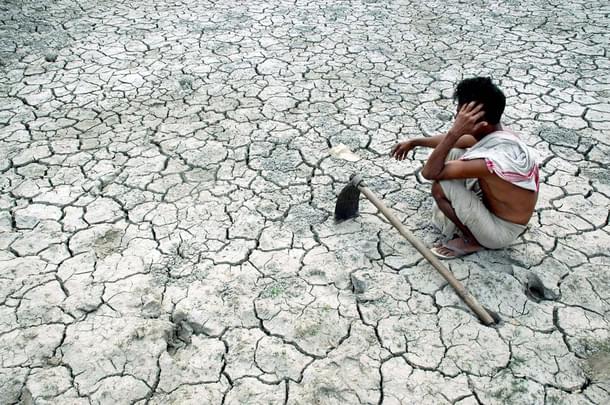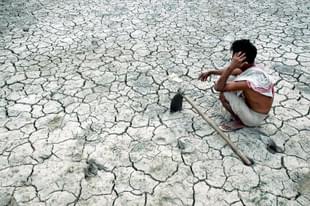Economy
El Nino Effect: Three Areas Of Concern For The Indian Economy
M R Subramani
Jul 01, 2019, 03:32 PM | Updated 03:31 PM IST
Save & read from anywhere!
Bookmark stories for easy access on any device or the Swarajya app.


June has passed by but it has left behind problems for Indian agriculture. Data on rainfall from the South-West Monsoon that began on 1 June, the storage levels in 91 important reservoirs and the data on kharif sowing — all show a negative trend.
According to the India Meteorological Department (IMD), the South-West Monsoon, which was delayed this year, has seen a 36 per cent deficient rainfall in June across the country. This is monsoon’s worst performance in the last five years. Twenty-seven of the 36 meteorological divisions in the country were rainfall deficient, while only five have got normal or excess rainfall.
Barring north Karnataka and east Rajasthan, almost all regions in the country have received less than normal rains since the monsoon set in this year. Regions like Jharkhand, Vidarbha, eastern Madhya Pradesh and western Uttar Pradesh received over 60 per cent less-than-normal rainfall.
The IMD has said that weak El Nino conditions that lead to drought and deficient rainfall in India are likely to continue throughout the monsoon season. El Nino is a weather phenomenon wherein the sea surface temperature in the Pacific Ocean rises and results in higher temperatures across the globe. The higher temperature in particular affects weather and rainfall in the Asian region.
The IMD has said that over the next two weeks Karnataka, Maharashtra, Andhra Pradesh, Telangana, Odisha, many parts of the North-East, Madhya Pradesh, east Rajasthan and many parts of Gujarat will receive above-normal rainfall. This could bring cheer to the worried farmers across the country, who depend on rains for the prospects of their crops.
India has been going through a particularly dry period since January this year and this has led to lower levels of water in various reservoirs across the country. According to the Central Water Commission (CWC), the storage level in the 91 important reservoirs is currently 15 per cent lower than the average seen in the last 10 years.
The storage level was 26.272 billion cubic metres (BCM) last week compared with 29.612 BCM during the same period last year. The storage level in the southern Indian states is worrisome since they are lower than the normal level by between 36 per cent and 84 per cent.
CWC data showed that storage level in Andhra Pradesh is 84 per cent lower than normal, while it is 36 per cent lower than normal in Telangana and Karnataka. The level in Tamil Nadu and Kerala is 47 per cent lower.
The water level in at least 13 reservoirs is zero, while in six others it was 10 per cent or less. However, the level was between 50 per cent and 60 per cent of normal storage level in 18 reservoirs. With the IMD forecasting heavy rainfall in the next two weeks, the storage situation will likely improve.
What the lower storage level and rainfall has done is to impact kharif sowing. In India, crops are cultivated in two seasons — kharif and rabi. Kharif sowing is done during the summer with the crops being harvested around October. Rabi sowing is done from November onwards with the harvest around March-April of the following year.
The kharif season is crucial for the country’s rice, cotton, oilseeds, pulses and coarse grains production. A majority of the crops, including horticulture and floriculture, are grown during kharif season and for this the performance of the south-west monsoon is crucial.
According to the Ministry of Agriculture and Farmers’ Welfare, sowing of crops in June was about 10 per cent lower compared with last year and nearly 25 per cent lower than the average sowing in the last five years.
Of great concern is the pulses acreage lagging behind by over 60 per cent compared with last year, while oilseeds sowing was lower during the review period. It is likely that farmers have been slow to start with their sowing operations as the monsoon set in late. July will hold the key for kharif prospects and if monsoon makes up for the June deficit then the overall situation will improve.
Agriculture’s contribution to the country’s GDP in the last couple of years has been lower and it is a worrisome factor. While last week’s prediction of the El Nino waning may be heartwarming, the New Zealand National Institute of Water and Atmospheric Research outlook isn’t optimistic.
It said there was a 60 per cent chance of El Nino continuing through September, though it would gradually weaken. Rainfall will increase only gradually, while there are other forecasts that predict hot weather will continue this week too. If the prediction turns out to be correct, then we are in trouble with the Indian monsoon.
This also means there may not be much to cheer for the Indian economy. A good kharif production is the key to rural India’s economy. If weather hits agriculture, then the buying power of the rural masses will be affected, leading to a downturn. Already, there are signs of the economy weakening what with sales of automobiles and white goods declining.
As Finance Minister Nirmala Sitharaman presents her maiden Budget on 5 July (Friday), one hopes the centre would have plans to meet any situation arising out of a deficient monsoon and poor kharif production. At this moment, a deficient monsoon, lower storage level in reservoirs and drop in acreage are three areas of major concern for the Indian economy.
M.R. Subramani is Executive Editor, Swarajya. He tweets @mrsubramani





